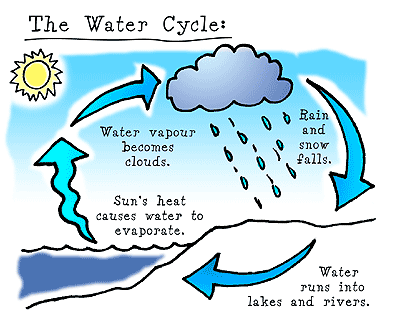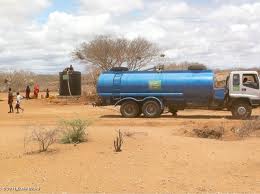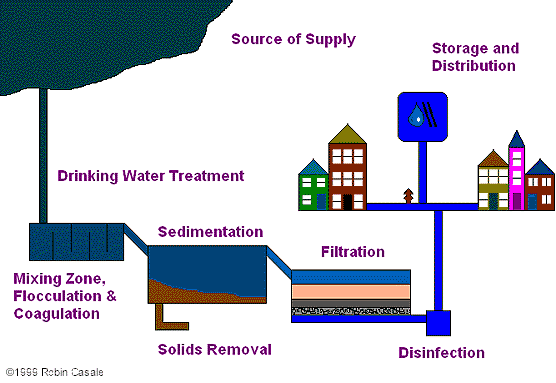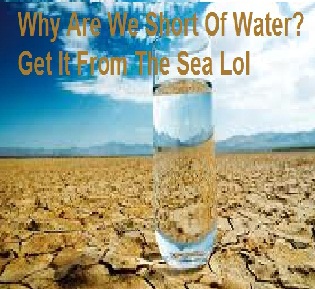How to change sea water into drinking water | Sea water can be converted into fresh, drinkable water by removing the salt and other minerals through desalination, which is a process that separates the salt from the water. The separation of salt can be done by four methods, filtering, freezing, boiling, and vacuum evaporation. Each process has positive and negative aspects that affect the favorability of one over the others. In the process of filtering the sea water, salt water is pumped from a container through a series of filters that help screen the heavier salt and dissolved minerals from the water that is allowed to pass through. Due to the miniscule size of the filter gaps, water has to be forced with enough pressure that ensures the water to pass through; otherwise it would never do so on its own. Because of the pressure requirement, the filter complexity, and the controlled quantity at any one time, this method consumes a lot of time, energy, and has a small output. During the freezing of sea water, the dissolved salt and other minerals are ejected from the crystallizing water. This process occurs naturally in Earth's oceans where the formation of sea ice occurs, and the ejection of the salt-concentrated water, known as brine, helps influence the flow of cold water currents. Unfortunately, not all the salt is ejected, as some of the salt remains trapped in pockets within the ice. Because this amount of salt remains in a natural setting, it is also possible to remain in an artificial process, which would require a melting process, before being frozen again. Multiple freezing and unfreezing sessions in different chambers would eventually yield ice that would be devoid of the salt, which could be later melted for drinking water. The fresh water could be ascertained by having the ability to freeze at a normal freezing point of 32 degrees Fahrenheit/0 degrees Celsius, due to the salt's lowering of the freezing point. By far the easiest method, boiling sea water evaporates the water and leaves the salt behind. Steam can be piped into a condenser or another chamber separate from the boiler, and cool into a liquid form. The cooled water should be devoid of salt. Additionally, large amounts of water can be added to the main boiler continuously. This means that so long as there is a heat source, the supply of fresh water can be maintained. The main problem is the heat source. Similar to evaporation through heat addition, a vacuum process uses a barometric pressure principle to create a vacuum in a tall tube with warm water. Because of the vacuum and decrease in pressure, water will evaporate at lower temperatures, and the resulting steam will be collected in a condenser in order to be converted back to liquid form. The system uses less energy to operate, and is also more efficient. To date, this is the best solution for the global community, often when waste heat from other applications is used to warm the water that is to be evaporated. |
Making drinking water from sea water has been touted as a solution for water shortage in the Middle-East and elsewhere. In southern Israel, near Ashkelon, a small pilot project has been pumping out 24 million cubic meters of fresh drinking grade water into Israel’s water system since 2005. Currently expanding its output to add another 45 million cubic meters a year, the facility is planning to produce 120 million cubic meters of fresh drinking water annually by 2013
When the Ashkelon plant went on the grid in 2005 using groundbreaking technology, the eyes of the world were watching with great interest. In an effort to deal with the challenges facing water management today, the Ashkelon facility offered an untried but hopeful solution. By applying a reverse osmosis system that had not yet been used on such a large scale the pilot project has proven to be extraordinarily successful.
With an on-site power plant operated by natural gas, the desalination facility pumps water from a point half a mile off the coast of Israel, filters it and then removes the water from the salt by running it through specially designed membranes. The water pumped by the Ashkelon plant currently supplies approximately 5% of Israel’s fresh water demand.
The reverse osmosis technology is considered to be the most effective technique available for the desalination of water. It’s long been in the middle of a persuasion campaign by Friends of the Earth Middle East in the Dead Sea, where they believe that installing such a system would benefit the rapidly falling water level in the Dead Sea.
However, while the fresh water plant in Ashkelon may represent a sort of utopian dream, sources in Israel’s Ministry of Environmental Affairs report that without proper supervision such interference in Israel’s natural resources will in the long run incur a steep price.
The desalination process by means of reverse osmosis is done in two steps.
First, a variety of chemicals are added to the seawater to help filter the floating particles. Before the filtering process, iron, phosphorus and other minerals are added to the water to identify foreign material. Then, the water is separated from all other materials and added directly into Israel’s water supply. The excess material is then pumped back to the sea.
The excess material includes all of the foreign chemicals added in the desalination process as well as all of the excess salts left over at the end of the process and hot water.
These materials are all returned to the Mediterranean, about a half-mile off shore, near the point from which the sea water was originally pumped out.
Right now, Israel’s Ministry of Environmental Affairs seems perhaps rightfully worried. With several other desalination plants under construction on the shoreline south of Tel Aviv, we can expect major changes in the marine environment, if careful existing safety measures aren’t enforced.
With the major changes being led by business conglomerates, that see water as a valuable resource in the future, they’re not sure these business groups have the marine environment high on their list of priorities. With so much money to be made it is highly doubtful their plans take the preservation of Israel’s delicate marine environment into account.
  |  |
Water Treatment and Distribution to Your Home
The following describes the basic steps used to make the water from our lakes, streams, rivers, and reservoirs safe to drink. Having an adequate, clean supply of water in our community ensures
- that everyone has safe water to drink,
- that businesses have the water necessary for commerce, and
- that the community has water available for fire protection.

Source: It is important that the sources we use for our water supply are good and clean and are readily available in an adequate amount.
Treatment: Treatment techniques remove soil and dirt, bacteria, viruses, and parasites, and chemical impurities. The steps include coagulation, flocculation, sedimentation, filtration, and disinfection.
Distribution: The Distribution System is the system of pipes that allows water to travel from the drinking water treatment plant to the homes and businesses in your community. The Distribution System is made up of pipes, pumps, valves, storage tanks, fire hydrants, and meters.
Coagulation and Flocculation: Gentle mixing of the water and treatment chemicals causes the impurities and particles to form larger floc particles. Chemicals commonly used for this process include aluminum sulfate (alum), ferric chloride, and synthetic polymers.
Sedimentation: The particles that are formed through coagulation and flocculation become increasingly larger and eventually settle out of the water in large sedimentation basins.
Filtration: After sedimentation, the clarified water is passed through filters to remove particles of dirt, algae, and harmful bacteria and parasites. Filters can be made from sand, gravel, coal, or granular activated carbon.
Disinfection: Disease-causing bacteria, viruses, and parasites are destroyed by disinfection. Chlorine and chlorine containing compounds are typically used for disinfection purposes. New disinfection technologies may also use ultraviolet light and ozone.
Solids Removal: Solids that settle out of the water are removed to drying lagoons or sludge presses for dewatering.
Water supply facts
- 97.5% of the earth's water is saltwater.
- The water we drink has been circling around in the water cycle for millions of years – that means the same water exists now as when the dinosaurs were on the Earth!
- The amount of fresh water supply provided by the hydrological cycle does not increase. Water everywhere on the planet is an integral part of the hydrologic cycle.
- Many major rivers are running dry – Colorado, Ganges, Indus, Rio Grande and Yellow – are so over-tapped that they now run dry for part of the year.
- Freshwater wetland has shrunk by about half worldwide.
- In 1972, the Yellow River in China failed to reach the sea for the first time in history. That year it failed on 15 days; every year since, it has run dry for a longer period of time, until in 1997, it failed to reach the sea for 226 days.
- The UK has less available water per person than most other European countries.
- London is drier than Istanbul, and the South East of England has less water available per person than the Sudan and Syria.
- Water is scarce in parts of Scotland, Wales and Northern Ireland as well as in England - large scale drought is already occurring in the UK, with the lowest rainfall, groundwater and reservoir levels for decades.
- A country is said to experience "water stress" when annual water supplies drop below 1,700 cubic meters per person. At levels between 1,700 and 1,000 cubic meters per person, periodic or limited water shortages can be expected. When annual water supplies drop below 1,000 cubic meters per person, the country faces water scarcity.
Water usage facts
- The average amount of water needed to produce one kilogramme of potatoes is 1000 litres, wheat is 1450 litres and rice is 3450 litres. (Gleick 2001)
- The average European uses 200 litres of water every day. North Americans use 400 litres.
- It takes 2,400 litres to produce a hamburger and 11,000 litres to make a pair of jeans, including the water needed to grow the cotton.
- The average person in the developing world uses 10 litres of water every day for their drinking, washing and cooking. (Water Supply and Sanitation Collaborative Council (WSSCC))
- An old lavatory uses at least nine litres of water a flush; a low-flush model uses as little as three litres. Each household in the UK uses about 50 litres a person a day for flushing – 35% of domestic water use. (Environment Agency)
- A normal individual uses from 135-140 litres of water daily.
- Filling a kettle consumes 2.5 litres of water, a bath takes 80 litres of water to be filled and by washing their clothes everyday an individual takes 65 litres of water to fill a washing machine up.
- Traditional baths use both more water and more energy than a shower does.
- Many businesses are literally pouring money down the drain by unnecessarily wasting water. If every business in the region leaves just one tap dripping for a day, a staggering 1.6 million litres of water would be wasted over the course of a year.
- To give you an idea: much of the company's waste water is now recycled in an automatic cleaning system and constitutes half of the cleaning water needed, while a moving beam cask washer reduced the amount of water required for cask cleaning by recycling the final rinse water.
- Each person in the UK currently uses about 150 litres of water every day. This has been rising by 1% a year since 1930. This consumption level is not sustainable in the long-term.
- Agriculture accounts for over 70% of the world's water consumption. (UN Environment Programme (UNEP))
- It takes at least 2,000 litres to produce enough food for one person for one day.
- Global water use is divided as follow: 70% Agriculture, 22% Industry, 8% Domestic.
Created By Mr Barry Horton On facebook


